Settings
This tutorial shows the development of a transport company starting in the year 1921. This particular game focuses on passenger and mail transport on rails, other means of transportation are not used. An additional goal is to focus on a somewhat realistic gameplay, i.e. the track layouts should look more or less like real railways.
It is often claimed that transporting passengers in the early game is not profitable. This is not true, since a passenger train practically never runs without passengers. A freight train runs fully loaded in one direction, but empty in the other. So when starting with sufficiently big cities, one can cash in lots of money with passengers just as well.
The game is based on a random 256x256 map with only a few cities and scarce industries in a hilly terrain. NewGrfs are only used for optical reasons, except for the DBSetXL and the Total Town Replacement set. Only the original industries are used, with the notable addition of an ancient grf that allows using paper as freight also in temperate climate (Download von TTDPatch.net).
Since the tutorial only focuses on a very general gameplay, difficulty settings can be chosen in an almost arbitrary way. However, breakdowns are disabled, since they are far too common in the game. Trains will be serviced in depots regularly (real steam trains need coal and even more water), this will be made sure by appropriate timetables. No other players (especially computer controlled ones) are active, since they would only mess up our game.
Note that I tend to build a lot and especially while pausing the game, since game time already runs quite fast and I want to be able to actually watch the trains on their way. But this is a personal habit, everyone may play as desired.
The first line
After having generated the map (observant readers will have noticed it is the same as for the freight tutorial) we pause the game and take a closer look at the overview map. It might be a good idea to take a large screenshot of the map and load it into some drawing program. Now one can simply sketch out a rough track layout without risking to lay tracks in an unnecessary complex and expensive way. Planning the track layout ahead will also save lots of trouble with later extensions and refinements!
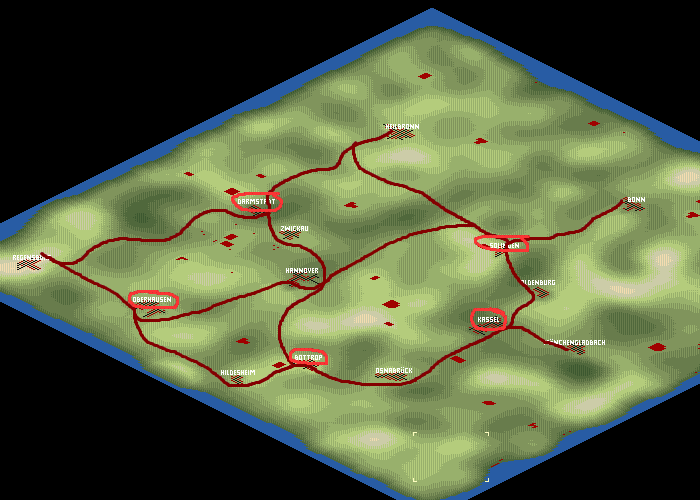 Planning the track layout is especially important for planning a useful
passenger network. Such a network can be seen in the screenshot, the red circles
denoting central hubs where changing trains should be possible, and where depots
will be built (a tribute to reality). Oberhausen is a special case, it is a hub
simply due to its size, in addition the terrain towards Hildesheim is quite
flat, but towards Regensburg there is a huge mountain in the way. Here we might
possibly need to use different types of engines, or electrify the line to
Regensburg.
Planning the track layout is especially important for planning a useful
passenger network. Such a network can be seen in the screenshot, the red circles
denoting central hubs where changing trains should be possible, and where depots
will be built (a tribute to reality). Oberhausen is a special case, it is a hub
simply due to its size, in addition the terrain towards Hildesheim is quite
flat, but towards Regensburg there is a huge mountain in the way. Here we might
possibly need to use different types of engines, or electrify the line to
Regensburg.
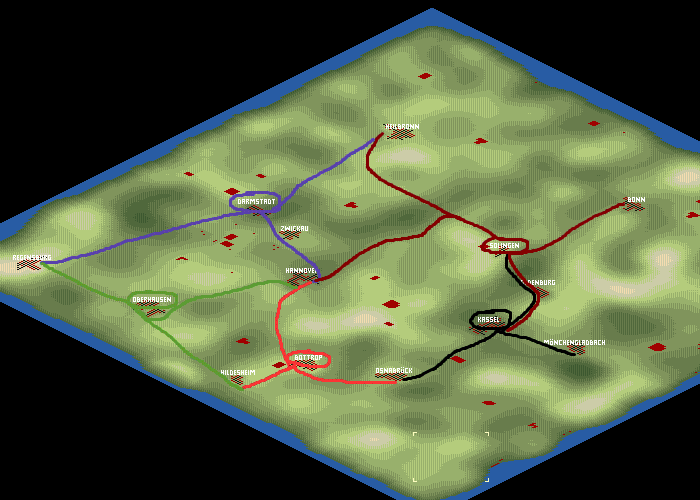 The second screenshot shows a more detailed plan, detailing the exact lines for
each passenger train starting at one of the hubs. This is also the base for
creating the network. Trains will need possibilities to change direction at the
end of their line, depots are required, and we should reserve extra space for
later additions of longer express trains. We are planning ahead quite a bit here.
The second screenshot shows a more detailed plan, detailing the exact lines for
each passenger train starting at one of the hubs. This is also the base for
creating the network. Trains will need possibilities to change direction at the
end of their line, depots are required, and we should reserve extra space for
later additions of longer express trains. We are planning ahead quite a bit here.
After so much planning we can finally start with building. As a start we choose one of the hubs, so that we can start the network in a central location. This allows for easier expansion, after the first lines are profitable.
Darmstadt is not a good choice for a start, since the terrain is very uneven. The same goes for Solingen, which is comparably small as well. Oberhausen only allows one simple line to Hildesheim in the beginning, which only leaves us with Bottrop or Kassel. Due to the slightly simpler terrain we choose Kassel.
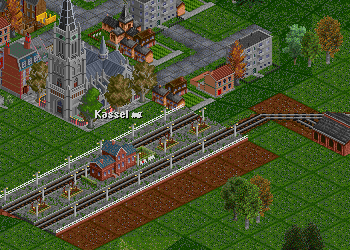 The station of Kassel, our first hub. Of course you cannot see that much of a
hub here right now. Currently, there is only a single track running to
Mönchengladbach. The station already has two platforms, as we are planning
to expand quite soon anyway.
The station of Kassel, our first hub. Of course you cannot see that much of a
hub here right now. Currently, there is only a single track running to
Mönchengladbach. The station already has two platforms, as we are planning
to expand quite soon anyway.
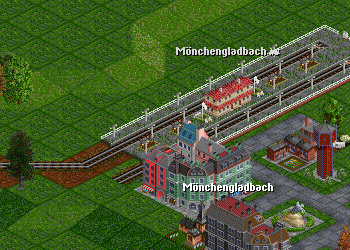 The other end of the line looks virtually identical. The station also has two
platforms, to have some capacity for later expansion. Typically it will be very
difficult to expand a station in a town, once the town has grown around the
station, therefore we built the second platform right at the beginning.
The other end of the line looks virtually identical. The station also has two
platforms, to have some capacity for later expansion. Typically it will be very
difficult to expand a station in a town, once the town has grown around the
station, therefore we built the second platform right at the beginning.
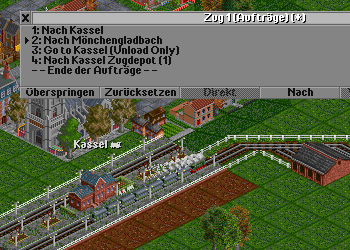 The first train leaves Kassel. In the picture you can see the timetable, note
the orders for servicing: The train heads towards Kassel, does not load there
and leaves empty, heading for the depot. After service it loads again and
departs for Mönchengladbach. This is just like in reality, where engines
are serviced regularly, especially steam engines which need coal and water in
regular intervals.
The first train leaves Kassel. In the picture you can see the timetable, note
the orders for servicing: The train heads towards Kassel, does not load there
and leaves empty, heading for the depot. After service it loads again and
departs for Mönchengladbach. This is just like in reality, where engines
are serviced regularly, especially steam engines which need coal and water in
regular intervals.
Adding trains
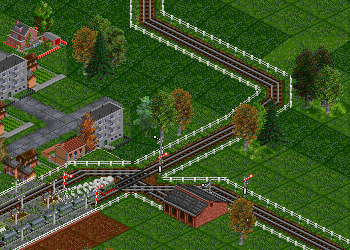 We do not hesitate to invest into a second line and another train. This line
only leads to Oldenburg, where the train has to turn around for now. Later on
this line is planned to lead to Solingen, but there is a deep valley between the
two towns that we cannot yet afford to cross with a bridge.
We do not hesitate to invest into a second line and another train. This line
only leads to Oldenburg, where the train has to turn around for now. Later on
this line is planned to lead to Solingen, but there is a deep valley between the
two towns that we cannot yet afford to cross with a bridge.
Signalling on the lines currently is only provisional with block signals. There is only one train per line at the moment, so we only need some signals around Kassel in order to avoid another expensive depot for every line.
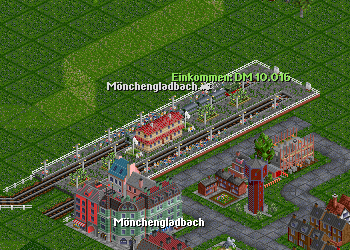 The first income is created in early April, and as can be seen in the picture,
the station is already well frequented with passengers. This will enable us to
work on our future plans.
The first income is created in early April, and as can be seen in the picture,
the station is already well frequented with passengers. This will enable us to
work on our future plans.
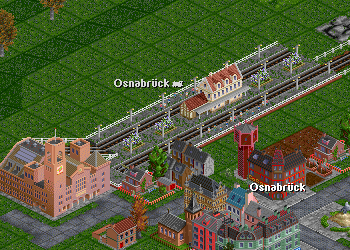 The third line from Kassel leads towards Osnabrück. This only leaves the
short part to Solingen to finish the basic hub of Kassel. However, the two
platforms are already becoming a bottleneck for our three trains. Before
introducing further trains we will have to upgrade here.
The third line from Kassel leads towards Osnabrück. This only leaves the
short part to Solingen to finish the basic hub of Kassel. However, the two
platforms are already becoming a bottleneck for our three trains. Before
introducing further trains we will have to upgrade here.
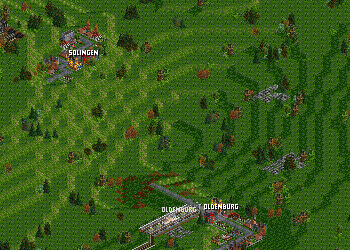 The overview picture shows the difficult topography between Oldenburg and
Solingen. Instead of bridging the valley it looks more promising to build around
it with a flat track.
The overview picture shows the difficult topography between Oldenburg and
Solingen. Instead of bridging the valley it looks more promising to build around
it with a flat track.
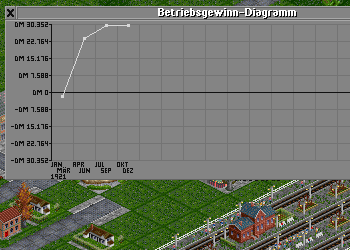 At the end of the first year our quarterly income is 30.000 Mark that can be
reinvested. We own three trains, the station at Kassel is almost fully
functional and the line towards Solingen is almost finished as well.
At the end of the first year our quarterly income is 30.000 Mark that can be
reinvested. We own three trains, the station at Kassel is almost fully
functional and the line towards Solingen is almost finished as well.
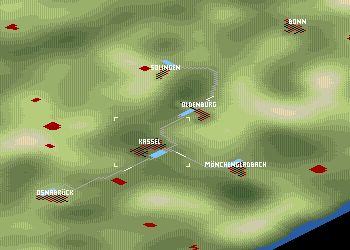 In early 1922 the network overview shows the central hub of Kassel and the
single tracked lines branching out from there. As we have already reached
Solingen (which will become another important station in our network), building
will concentrate on the line from Solingen to Bonn.
In early 1922 the network overview shows the central hub of Kassel and the
single tracked lines branching out from there. As we have already reached
Solingen (which will become another important station in our network), building
will concentrate on the line from Solingen to Bonn.
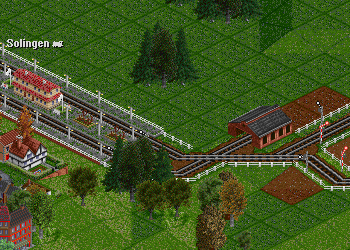 In 1922 the station of Solingen connected to a new line towards Bonn. A small
depot is build as well, but most importantly we buy another two trains and
lengthen the existing ones, since passengers queue up at Kassel. The line
Solingen-Kassel via Oldenburg is therefore to be serviced by two trains. This
means we upgrade the station at Oldenburg to allow the trains to pass each
other, while the rest of the line remains single tracked.
In 1922 the station of Solingen connected to a new line towards Bonn. A small
depot is build as well, but most importantly we buy another two trains and
lengthen the existing ones, since passengers queue up at Kassel. The line
Solingen-Kassel via Oldenburg is therefore to be serviced by two trains. This
means we upgrade the station at Oldenburg to allow the trains to pass each
other, while the rest of the line remains single tracked.
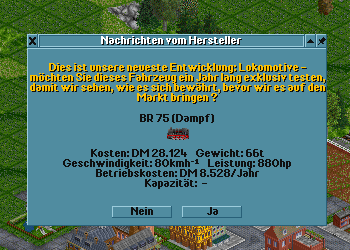 The third line from Solingen would either lead to Heilbronn or to Hannover, but
the distances are still much too big for our trains, that currently only crawl
at 50 kph. The line is therefore postponed until faster engines are available.
Instead we connect Bottrop to our network, forming the line Kassel-Bottrop via
Osnabrück. In parallel the class 75 is presented as first new engine,
capable of reaching 80 kph, which means the older class 92 is to be taken out of
service as soon as possible.
The third line from Solingen would either lead to Heilbronn or to Hannover, but
the distances are still much too big for our trains, that currently only crawl
at 50 kph. The line is therefore postponed until faster engines are available.
Instead we connect Bottrop to our network, forming the line Kassel-Bottrop via
Osnabrück. In parallel the class 75 is presented as first new engine,
capable of reaching 80 kph, which means the older class 92 is to be taken out of
service as soon as possible.
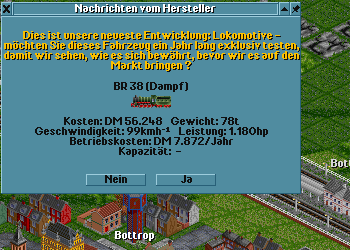 Only half a year later the class 38 is introduced. It reaches 100 kph and will
form the backbone of passenger service for decades to come. By now we have laid
out the basic tracks for the station at Bottrop, which is to become another hub
in our network. From here we will branch out towards Hannover and from there to Solingen.
Only half a year later the class 38 is introduced. It reaches 100 kph and will
form the backbone of passenger service for decades to come. By now we have laid
out the basic tracks for the station at Bottrop, which is to become another hub
in our network. From here we will branch out towards Hannover and from there to Solingen.
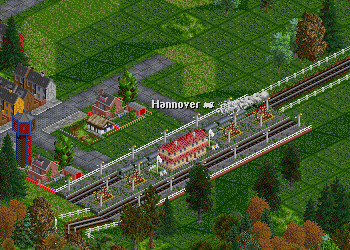 In October 1924 Hannover is connected to both Bottrop and Solingen. In the
picture the first train to leave Hannover can be seen, a passenger train
equipped with a class 38 heading for Solingen.
In October 1924 Hannover is connected to both Bottrop and Solingen. In the
picture the first train to leave Hannover can be seen, a passenger train
equipped with a class 38 heading for Solingen.
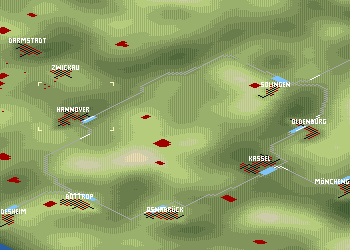 The network overview shows the situation of October 1924. About half the cities
are connected, and of course the lines are only built in a very basic way using
single tracks. Currently the main focus is to create the connections and
transport passengers to boost city growth. Only bigger cities will eventually
allow express trains to be profitable. Our next step will be the the connection
to Oberhausen (to the left of Bottrop).
The network overview shows the situation of October 1924. About half the cities
are connected, and of course the lines are only built in a very basic way using
single tracks. Currently the main focus is to create the connections and
transport passengers to boost city growth. Only bigger cities will eventually
allow express trains to be profitable. Our next step will be the the connection
to Oberhausen (to the left of Bottrop).
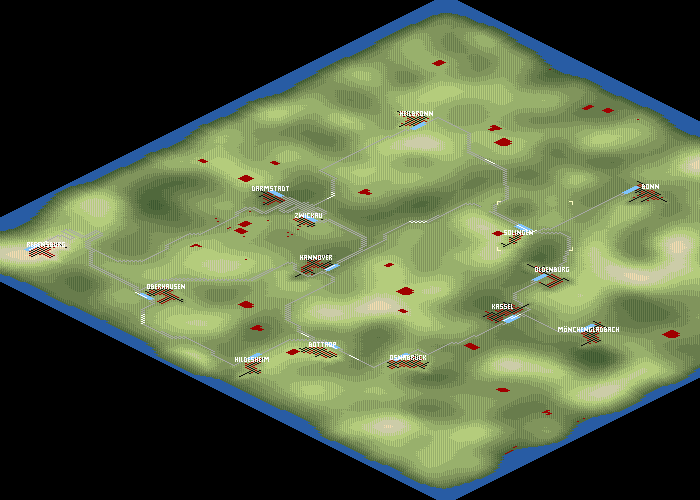
By 1928 we have finished the basic network with all hubs in place as planned at the start of the game. When comparing this image to the original plan one will see some minor differences near Darmstadt and Heilbronn. These were caused by the terrain, it was easier to build around hills and valleys instead of having to cross them. The line from Solingen to Heilbronn was built differently, as was the line from Darmstadt to Regensburg. The latter now also allows quite an easy additional line from Darmstadt to Oberhausen, which was not part of the original plan. Between Zwickau and Darmstadt a lot of tracks can be seen, here the line has to climb very steeply, with only limited space available. Therefore we also built this line double tracked from the beginning, to prevent space problems with later upgrades.
We continue with a consolidation of our running stock. By now, larger wagons are available which replace the smaller early ones. That also means that the last remaining units of class 75 are scrapped and replaced by class 38, which is both faster and cheaper.
Network creation
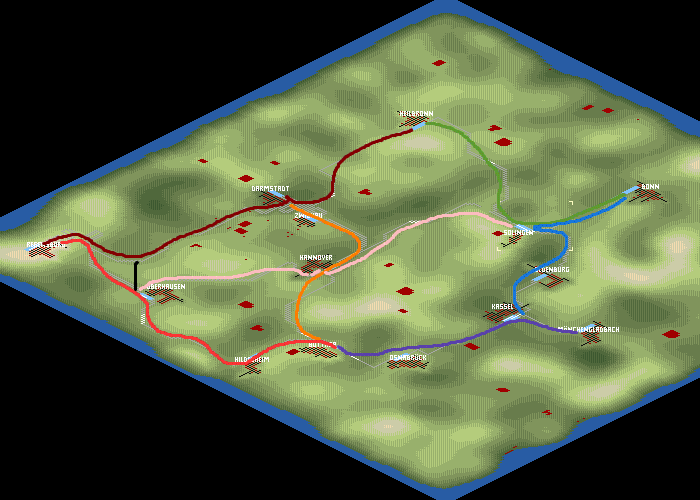
After having finished the basic passenger network we now want to establish a network of faster connections. These trains will connect the major cities to provide fast connections to all parts of the map. The picture shows one possible line configuration for such a network. Colors mark the various lines, with black showing a new track allowing a direct connection between Darmstadt and Oberhausen.
Based on this plan we now have to upgrade all our tracks and stations. Each line has to be double tracked, the stations will get more and longer platforms. Passenger trains will have a maximum length of 5 tiles, fast and express trains may have a length of up to 8 tiles.
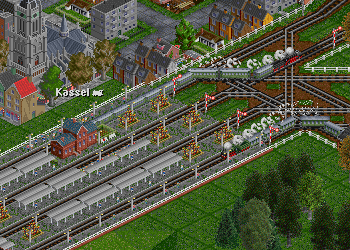 The first station to be upgraded is Kassel. The station now has four platforms,
with two of them allowing trains to continue towards Osnabrück, the other
two for trains turning around at Kassel. The image shows one of the new fast
trains, hauled by a class 18, on its way towards Solingen, while a passenger
train leaves the depot to collect passengers at Kassel.
The first station to be upgraded is Kassel. The station now has four platforms,
with two of them allowing trains to continue towards Osnabrück, the other
two for trains turning around at Kassel. The image shows one of the new fast
trains, hauled by a class 18, on its way towards Solingen, while a passenger
train leaves the depot to collect passengers at Kassel.
Entry to the platforms is regulated using restricted signals, a feature which is only available in TTDPatch. In OpenTTD one would have to use waypoints to achieve a similar effect.
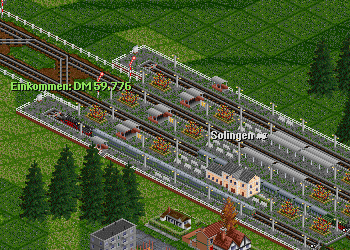 The station at Solingen has been upgraded as well, here one can also get a
glimpse at how much money a fully loaded passenger train can generate. To the
left the lines continue to Heilbronn and Hannover and possibly towards Zwickau
and Darmstadt once this line has been built.
The station at Solingen has been upgraded as well, here one can also get a
glimpse at how much money a fully loaded passenger train can generate. To the
left the lines continue to Heilbronn and Hannover and possibly towards Zwickau
and Darmstadt once this line has been built.
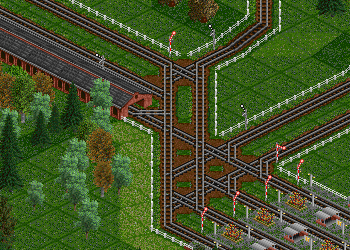 More upgrades can be found at the station of Oberhausen. At the top of the
picture the new track allowing a direct connection to Darmstadt can be seen, the
line to Hannover is on the right and the mountain line to Regensburg on the
left.
More upgrades can be found at the station of Oberhausen. At the top of the
picture the new track allowing a direct connection to Darmstadt can be seen, the
line to Hannover is on the right and the mountain line to Regensburg on the
left.
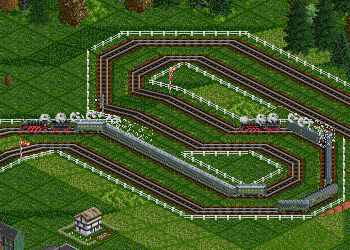 Regensburg is situated on top of a hill, the climb is only possible with a very
curvy track. Here a fast train tackles the climb, while a passenger train with a
class 38 rolls downwards. This mountain line is the prime candidate for
electrication in our network.
Regensburg is situated on top of a hill, the climb is only possible with a very
curvy track. Here a fast train tackles the climb, while a passenger train with a
class 38 rolls downwards. This mountain line is the prime candidate for
electrication in our network.
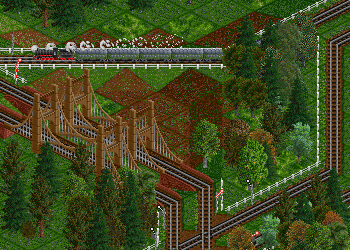 Another new improvement in our network is a track connecting the lines Hannover-
Solingen and Hannover-Darmstadt to create a direct connection between Solingen
and Darmstadt. The picture shows a train on that new track, Hannover is towards
the South, Solingen towards the East, the train is heading for Darmstadt.
Another new improvement in our network is a track connecting the lines Hannover-
Solingen and Hannover-Darmstadt to create a direct connection between Solingen
and Darmstadt. The picture shows a train on that new track, Hannover is towards
the South, Solingen towards the East, the train is heading for Darmstadt.
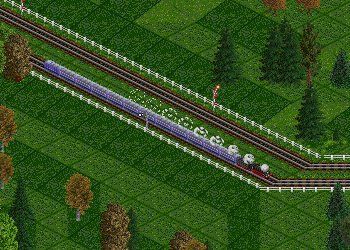 By the end of the 1920s the new Rhinegold express trains are ingaugurated. This
train travels along a ring line connecting all major cities in the network:
Oberhausen, Darmstadt, Heilbronn, Solingen, Kassel and Bottrop (and vice versa).
It uses the connecting track near Oberhausen.
By the end of the 1920s the new Rhinegold express trains are ingaugurated. This
train travels along a ring line connecting all major cities in the network:
Oberhausen, Darmstadt, Heilbronn, Solingen, Kassel and Bottrop (and vice versa).
It uses the connecting track near Oberhausen.
So in the early 1930s the network is almost complete: All lines have been doubletracked, stations and depots are large enough for future tasks, and a wide variety of trains in various services runs on our network.
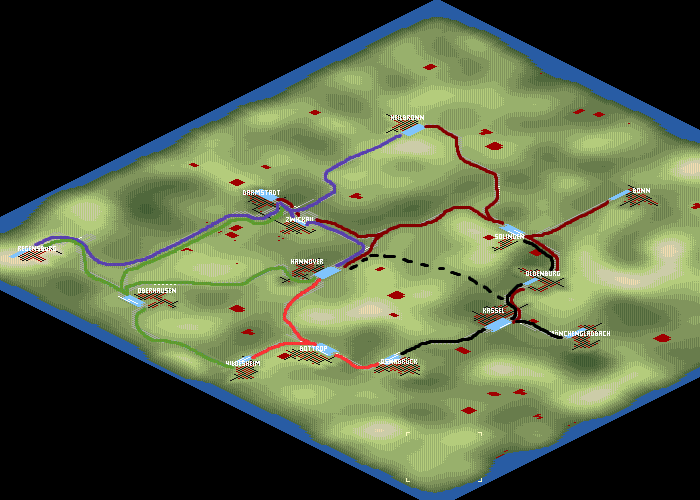 The overview map shows the passenger train network in 1935. The different colors
mark the base depots from where trains are maintained. The black dots mark a new
track that is to be built to connect Kassel and Darmstadt with the shortest
route possible. This also allows a shorter connection between Kassel and
Hannover and opens up a number of possibilities for improved overall connections
within the whole network.
The overview map shows the passenger train network in 1935. The different colors
mark the base depots from where trains are maintained. The black dots mark a new
track that is to be built to connect Kassel and Darmstadt with the shortest
route possible. This also allows a shorter connection between Kassel and
Hannover and opens up a number of possibilities for improved overall connections
within the whole network.
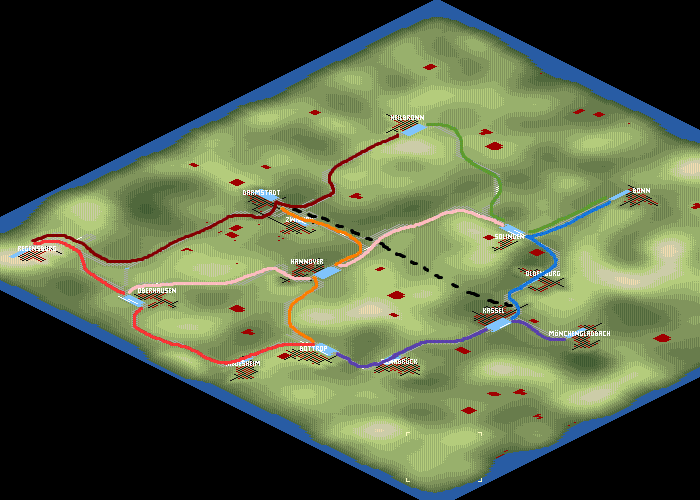 The network of fast trains already looks quite complete in 1935. Fast trains
always connect two major hubs. In addition there is the Rhinegold on its ring
line between the major stations. The black dots again mark the new planned track
for fast trains between Kassel and Darmstadt. Additional express trains are
planned for both a western and an eastern ring line. The split between both
rings runs across the axis Oberhausen-Hannover-Solingen.
The network of fast trains already looks quite complete in 1935. Fast trains
always connect two major hubs. In addition there is the Rhinegold on its ring
line between the major stations. The black dots again mark the new planned track
for fast trains between Kassel and Darmstadt. Additional express trains are
planned for both a western and an eastern ring line. The split between both
rings runs across the axis Oberhausen-Hannover-Solingen.
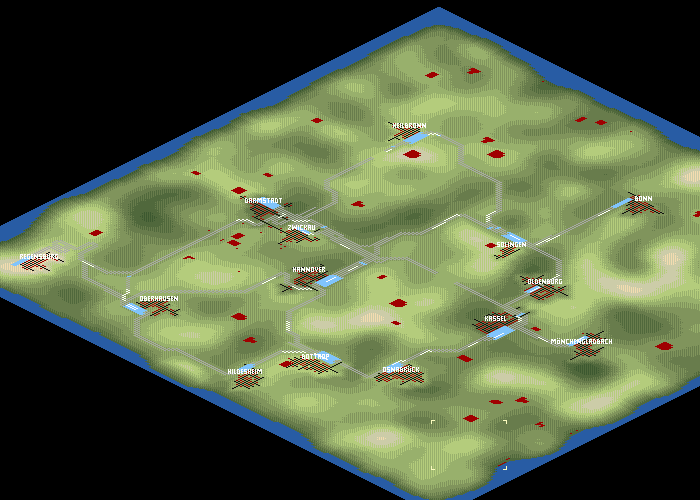 In 1938 the new line is finally finished. It connects Kassel and Darmstadt,
bypasses the hill where Zwickau is situated and contains a connection towards
Hannover as well. While building this line, the entries to the stations of
Kassel and Hannover have been rebuilt to reduce traffic problems. The line
between Kassel and Solingen needs an upgrade as well, and the station of
Solingen has to be enlarged and upgraded with a better connection to the depot,
as trains often block the whole station entry there. So there still is plenty to do.
In 1938 the new line is finally finished. It connects Kassel and Darmstadt,
bypasses the hill where Zwickau is situated and contains a connection towards
Hannover as well. While building this line, the entries to the stations of
Kassel and Hannover have been rebuilt to reduce traffic problems. The line
between Kassel and Solingen needs an upgrade as well, and the station of
Solingen has to be enlarged and upgraded with a better connection to the depot,
as trains often block the whole station entry there. So there still is plenty to do.
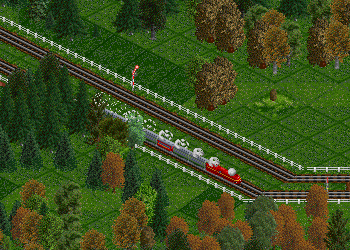 The fastest train on the network is this express train running on the new line
from Darmstadt to Kassel. It is hauled by a class 05 and reaches more than 150
kph. However, this engine is only suited for flat tracks, even the smallest hill
is beyond its limited tractive effort.
The fastest train on the network is this express train running on the new line
from Darmstadt to Kassel. It is hauled by a class 05 and reaches more than 150
kph. However, this engine is only suited for flat tracks, even the smallest hill
is beyond its limited tractive effort.
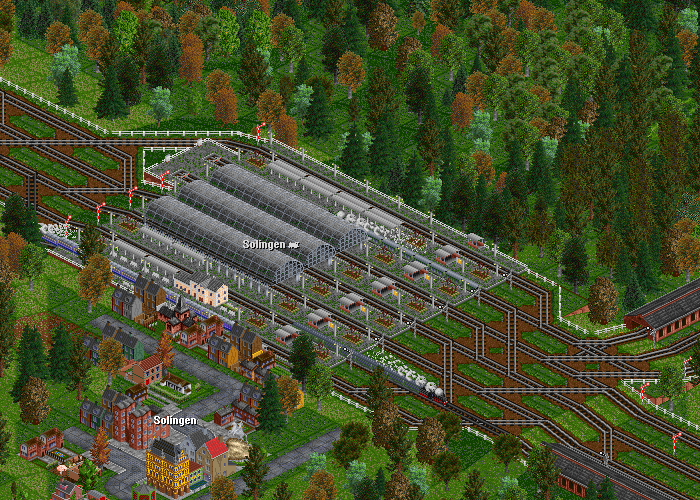 Solingen has been upgraded again because trains queued much too heavily because
of the need to cross the whole station entry when heading for the depots. The
station now contains seven platforms, five for through traffic, two for trains
towards Kassel and Bonn, which turn around at Solingen. Towards the right there
are three tracks leading to Kassel, next to the depot at the top there is the
line towards Bonn. On the other end of the station four tracks lead towards the
West, two waypoints sort traffic to Heilbronn and Hannover/Darmstadt there.
Trains are directed to the correct platforms using restricted signalling, which
is only available in TTDPatch (in OpenTTD one would need to use waypoints).
Solingen has been upgraded again because trains queued much too heavily because
of the need to cross the whole station entry when heading for the depots. The
station now contains seven platforms, five for through traffic, two for trains
towards Kassel and Bonn, which turn around at Solingen. Towards the right there
are three tracks leading to Kassel, next to the depot at the top there is the
line towards Bonn. On the other end of the station four tracks lead towards the
West, two waypoints sort traffic to Heilbronn and Hannover/Darmstadt there.
Trains are directed to the correct platforms using restricted signalling, which
is only available in TTDPatch (in OpenTTD one would need to use waypoints).
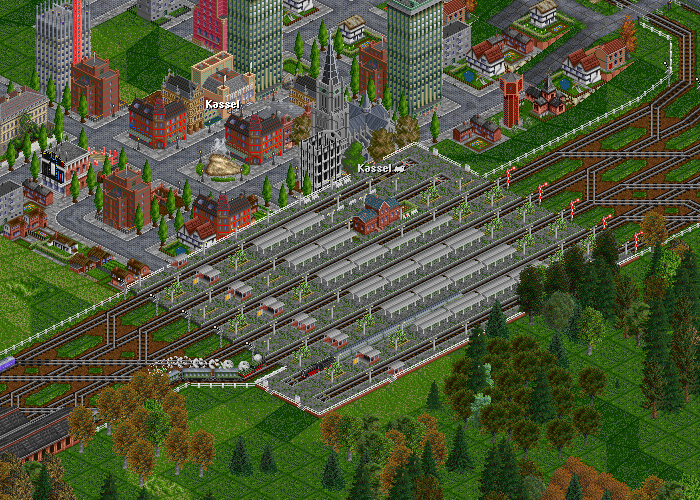 Another major upgrade was done around the station of Kassel, since the two
platforms for trains arriving from Hannover, Darmstadt, Solingen and
Mönchengladbach were not enough. The depots were relocated to the western
side of the station, so that now there are three platforms which can be used in
both directions. The other four platforms are for trains that turn around at
Kassel, two per direction. Station entries have been changed to minimize the
number of crossing train paths. This allows for more trains entering and leaving
the station simultaneously.
Another major upgrade was done around the station of Kassel, since the two
platforms for trains arriving from Hannover, Darmstadt, Solingen and
Mönchengladbach were not enough. The depots were relocated to the western
side of the station, so that now there are three platforms which can be used in
both directions. The other four platforms are for trains that turn around at
Kassel, two per direction. Station entries have been changed to minimize the
number of crossing train paths. This allows for more trains entering and leaving
the station simultaneously.
The other major hubs, Bottrop, Oberhausen and Darmstadt, are upgraded in a similar way. Many trains visit these stations, and due to the depots there is a lot of extra traffic.
By 1944 the network upgrade is completed. The last major station to be enlarged was Darmstadt. In addition to the difficult terrain and the lack of space the local authorities were not too cooperative, requiring us to build lots and lots of trees before being able to add some more platforms.
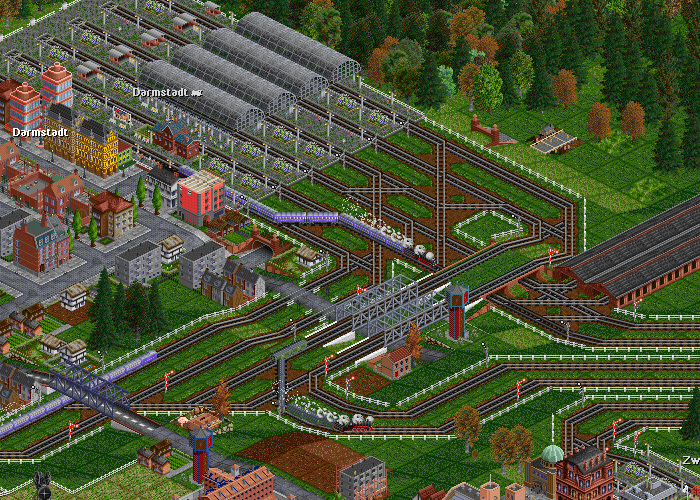
Electrification
During the 1940s, about 20 years after the first electric engines became available, we finally start with the electrification of the steepest part of the network. The mountain line towards Regensburg has six ramps and is used by both passenger and fast trains. Steam engines have loads of trouble keeping up the speed in this part of the track, so it is the ideal testing ground for electric engines.
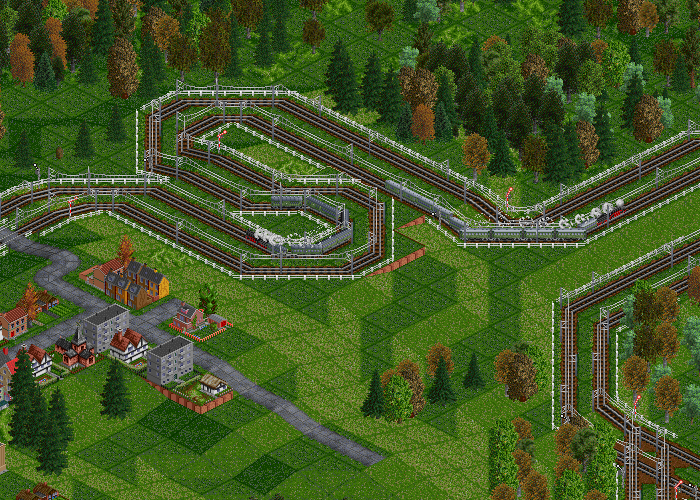 Overhead wires are already installed, only the trains are missing. The early
models, like class E16 and E52 are comparably expensive, and their design is
already outdated by 20 years. Instead we use the solid class E44. It might be 10
kph slower compared to the steam engines of class 38, but it can keep up the
speed in the mountains where the steamers struggle to reach 50 kph.
Overhead wires are already installed, only the trains are missing. The early
models, like class E16 and E52 are comparably expensive, and their design is
already outdated by 20 years. Instead we use the solid class E44. It might be 10
kph slower compared to the steam engines of class 38, but it can keep up the
speed in the mountains where the steamers struggle to reach 50 kph.
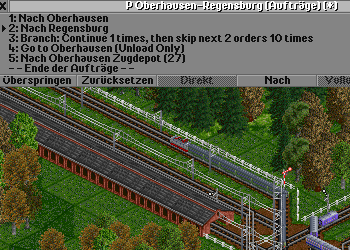 Electric engines also have another advantage: They need service much more
seldomly. Steam engines need regular servicing with water and coal (which means
we plan a stop at the depot for every tour to simulate that). Electric engines
do not need that, so we can change the schedules. The timetable is completed 10
times before a planned service takes place. The picture shows the first train to
be hauled by an electric engine on the line from Oberhausen to Regensburg, as
well as its timetable.
Electric engines also have another advantage: They need service much more
seldomly. Steam engines need regular servicing with water and coal (which means
we plan a stop at the depot for every tour to simulate that). Electric engines
do not need that, so we can change the schedules. The timetable is completed 10
times before a planned service takes place. The picture shows the first train to
be hauled by an electric engine on the line from Oberhausen to Regensburg, as
well as its timetable.
We continue to upgrade the lines around Oberhausen to electric traction. It is not yet needed to electrify other lines, since the steam engines are good enough for another 20 years and the current electric engines are not that much faster of stronger. For freight engines, the situation would be different, as the classes E94 and E95 outperform every steamer - however, we do not play with freight trains.
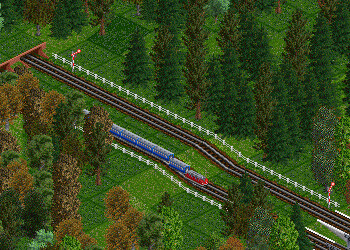 There are also some new trains on the non-electrified tracks. The super fast
class 05 has always been prone to breakdowns and has reached the end of its
lifetime already in the late 1950s. It is replaced by a so-called F-train, an
express train in blue livery hauled by the new diesel engine of class V200. This
engine reaches 140 kph, which is not as fast as the class 05, but the V200 is
more reliable.
There are also some new trains on the non-electrified tracks. The super fast
class 05 has always been prone to breakdowns and has reached the end of its
lifetime already in the late 1950s. It is replaced by a so-called F-train, an
express train in blue livery hauled by the new diesel engine of class V200. This
engine reaches 140 kph, which is not as fast as the class 05, but the V200 is
more reliable.
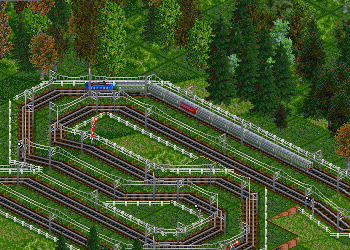 The great breakthrough for electric trains arrives in the late 1950s with the
introduction of the standard electric engines of classes 110, 140 and 150. The
latter is only interesting for heavy freight trains, the 110 is the right choice
for fast and express trains, while the 140 is kind of an universal engine for
passenger trains. Here we see a fast train with dining car, hauled by a class
110 on the mountain line to Regensburg. Trains on the electrified lines are now
modernized with the new rolling stock one after another.
The great breakthrough for electric trains arrives in the late 1950s with the
introduction of the standard electric engines of classes 110, 140 and 150. The
latter is only interesting for heavy freight trains, the 110 is the right choice
for fast and express trains, while the 140 is kind of an universal engine for
passenger trains. Here we see a fast train with dining car, hauled by a class
110 on the mountain line to Regensburg. Trains on the electrified lines are now
modernized with the new rolling stock one after another.
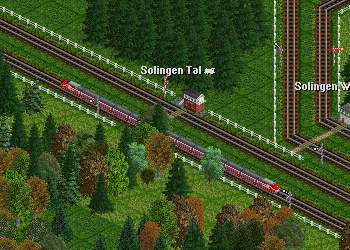 The Rhinegold trains of the late 1920s are to be replaced as well. Since there
are still lines that have not yet been equipped with overhead wires, we chose
the new Trans-Europ-Express trains of class VT11.5, which are powered by Diesel
engines. This is only a temporary solution, since it is quite clear that all
major lines (and there are only major lines on this map) will be electrified
sooner or later.
The Rhinegold trains of the late 1920s are to be replaced as well. Since there
are still lines that have not yet been equipped with overhead wires, we chose
the new Trans-Europ-Express trains of class VT11.5, which are powered by Diesel
engines. This is only a temporary solution, since it is quite clear that all
major lines (and there are only major lines on this map) will be electrified
sooner or later.
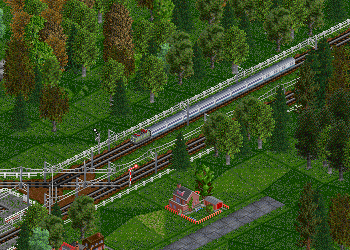 The steamers of class 38 are becoming old, having been in service for more
than 40 years now. As electrification goes on, they are replaced with class 140
and silverfish coaches, that will form the new backbone of passenger
transportation.
The steamers of class 38 are becoming old, having been in service for more
than 40 years now. As electrification goes on, they are replaced with class 140
and silverfish coaches, that will form the new backbone of passenger
transportation.
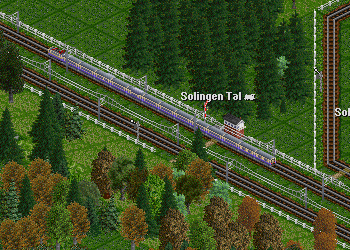 In 1961 a new express train is introduced, which is marketed as a new version of
the Rhinegold trains and hauled by a class 110 in special livery. The train
features a dome car and a dining car and runs from one end of the map to the
other on the line Regensburg, Oberhausen, Hannover, Solingen, Bonn and back. The
lines from Hannover to Solingen and Bonn were electrified to allow this train to
run, so that we have already completed electrification of one third of the
network.
In 1961 a new express train is introduced, which is marketed as a new version of
the Rhinegold trains and hauled by a class 110 in special livery. The train
features a dome car and a dining car and runs from one end of the map to the
other on the line Regensburg, Oberhausen, Hannover, Solingen, Bonn and back. The
lines from Hannover to Solingen and Bonn were electrified to allow this train to
run, so that we have already completed electrification of one third of the
network.
In the following years electrification does not really continue. The oldest steam engines are scapped, with some of them being replaced by diesel engines, if the line has not yet been electrified. This results in a couple of units of class V100 being put into service in the mid 1960s.
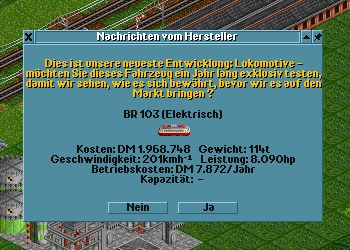 This news of 1970 marks the start of the full electrification: The engines of
class 103 are faster and stronger than anything else on our network. We plan to
electrify all lines that are used by express trains. On our map this means we
need to electrify every line. The new class 103 will replace the diesel powered
TEE units, at the same time we will replace the last engines of class 38, which
are now well over their lifetime.
This news of 1970 marks the start of the full electrification: The engines of
class 103 are faster and stronger than anything else on our network. We plan to
electrify all lines that are used by express trains. On our map this means we
need to electrify every line. The new class 103 will replace the diesel powered
TEE units, at the same time we will replace the last engines of class 38, which
are now well over their lifetime.
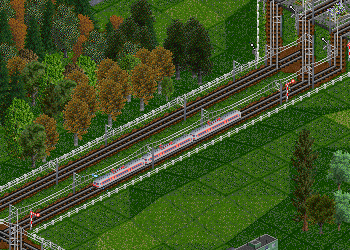 The new class 420 EMU is a good choice for regional traffic: It is specifically
designed to allow very fast passenger exchange, which means loading times at the
stations are reduced drastically, compared to the older "Silverfish" coaches. In
addition, it is faster than a class 140, which now leads to the paradoxon of
having regional traffic which is faster than the express trains hauled by the
old class 01 steam engines... meaning they will have to be replaced as well.
The new class 420 EMU is a good choice for regional traffic: It is specifically
designed to allow very fast passenger exchange, which means loading times at the
stations are reduced drastically, compared to the older "Silverfish" coaches. In
addition, it is faster than a class 140, which now leads to the paradoxon of
having regional traffic which is faster than the express trains hauled by the
old class 01 steam engines... meaning they will have to be replaced as well.
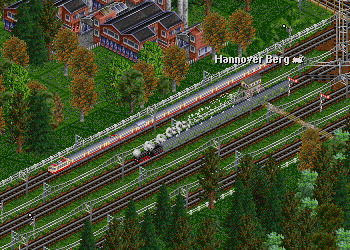 Old and new together: An express train hauled by a modern class 103 electric
engine next to a regional train with an old steamer. The track has already been
electrified, the end of service for steam engines draws near.
Old and new together: An express train hauled by a modern class 103 electric
engine next to a regional train with an old steamer. The track has already been
electrified, the end of service for steam engines draws near.
In 1974 a new coloring scheme is introduced, replacing all older mixtures of green and blue. This also means we reduce the mixture of engine classes and concentrate on a few core types: Express trains will be hauled by class 103 (200 kph) and are colored in red-cream, fast trains are the domain of class 110 (150 kph) and are blue-cream, and regional trains are pulled by class 140 (110 kph) or consist of class 420 EMUs (140 kph). Other types are replaced, even though that means some fairly young diesel engines of type V100 are scrapped.
The result can be seen in the screenshot, taken in the mid 70ies: A regional train enters the station from the left, to the right an express train leaves, and another express and a fast train can be seen at the station.
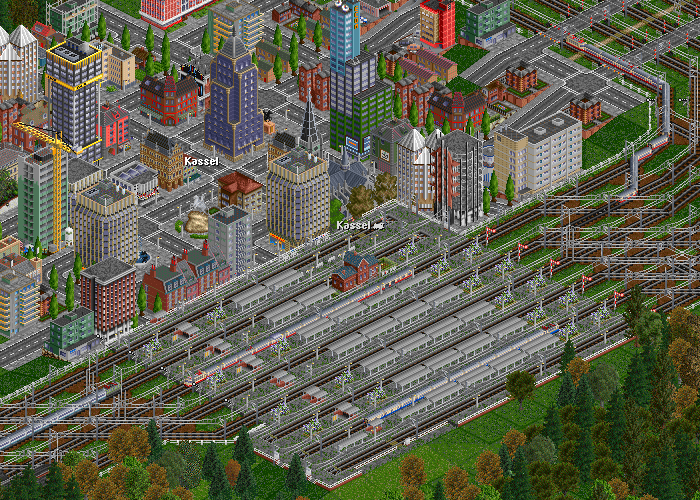
High speed tracks
In 1990, the first ICE (InterCity-Express) becomes available. With a top speed of 280 kph it is nearly twice as fast as the other trains and still 80 kph faster than the second fastest class 103. However, this is useless as long as the trains have to use the same tracks as the slow passenger trains - they would always block it from reaching the top speed. The solution for that problem are new lines that connect the main hubs directly and bypass the stations in between. The map shows the planned tracks, and one can also see how much the cities have grown since the start of the game.
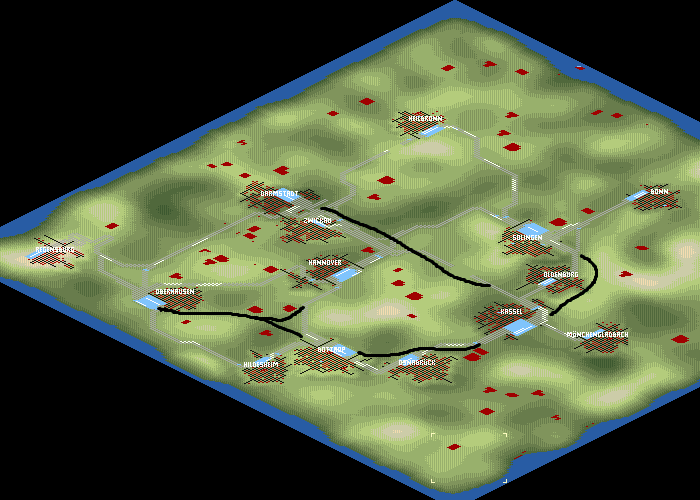
The longest new line forms a straight line connection between Kassel and Darmstadt. The main goal is to connect Darmstadt in the most efficient way, bypassing all the complex tracks around Zwickau which are also used by many slower trains.
The second line leads from Kassel to Bottrop and from there to Oberhausen. This line mainly forms a bypass for the stations of Osnabrück and Hildesheim, especially since the lines also see heavy traffic congestion. The additional line connecting Oberhausen and Hannover is planned to reduce traffic on the old line that has some tight corners near Hannover which restrict top speed of our fast trains.
The third and most ambitious project is the bypass of Oldenburg, as the terrain is very mountaineous here and one has to cut through the mountains somehow. In general, the goal for these new lines is to build as flat and straight as possible, even if that would mean lots of bridges and tunnels - it is the only way to allow these trains to reach their top speed.
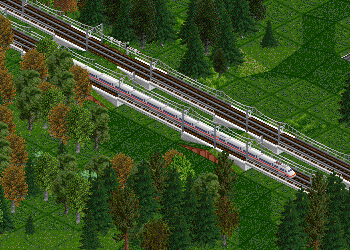 The first line can be built easily, so the first ICE trains are on their way in
1991 and improve our balance sheet considerably. However we also see that the
trains are rather poor in their acceleration, so it is only really suited to the
long line Kassel-Darmstadt. The other lines with more intermediate stations will
be serviced by the older trains with class 103, which benefit from not being
blocked by slower passenger trains as well.
The first line can be built easily, so the first ICE trains are on their way in
1991 and improve our balance sheet considerably. However we also see that the
trains are rather poor in their acceleration, so it is only really suited to the
long line Kassel-Darmstadt. The other lines with more intermediate stations will
be serviced by the older trains with class 103, which benefit from not being
blocked by slower passenger trains as well.
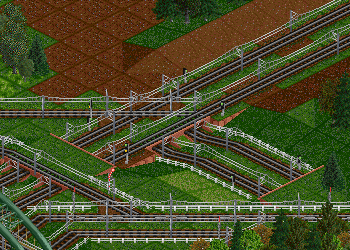 Apart from the completely new lines there are some existing tracks that can be
modified and upgraded. Typically they are straightened out to allow higher top
speeds. Here we see the crossing near Hannover, the brown areas are where the
old tracks were located. The new tracks lead to Solingen in a straighter way.
The short piece of line visible between the tunnels belongs to the high speed
line Kassel-Darmstadt. One can see that the lines have gotten pretty complicated
over the years.
Apart from the completely new lines there are some existing tracks that can be
modified and upgraded. Typically they are straightened out to allow higher top
speeds. Here we see the crossing near Hannover, the brown areas are where the
old tracks were located. The new tracks lead to Solingen in a straighter way.
The short piece of line visible between the tunnels belongs to the high speed
line Kassel-Darmstadt. One can see that the lines have gotten pretty complicated
over the years.
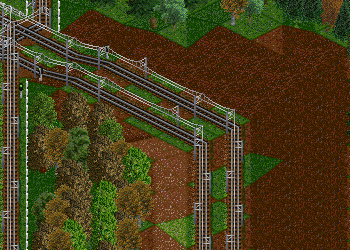 Since tunnels cannot contain curves we are faced with serious troubles in hilly
terrain. In order to get a useful result with flat tracks we have to do huge
amounts of terraforming. Here we can see a part of the new line between Solingen
and Kassel which bypasses Oldenburg (the old tracks that are now used by
regional services only can be seen to the left). With such a lot of changes to
the landscape it is no surprise that the city authorities of Oldenburg do not
like us.
Since tunnels cannot contain curves we are faced with serious troubles in hilly
terrain. In order to get a useful result with flat tracks we have to do huge
amounts of terraforming. Here we can see a part of the new line between Solingen
and Kassel which bypasses Oldenburg (the old tracks that are now used by
regional services only can be seen to the left). With such a lot of changes to
the landscape it is no surprise that the city authorities of Oldenburg do not
like us.
 Between Kassel and Bottrop we bypass Osnabrück. The new line is built more or
less parallel to the old one. The image shows an express train near Kassel, with
an older fast train approaching towards Osnabrück. The new line leads through
the tunnel into the station of Kassel to the right.
Between Kassel and Bottrop we bypass Osnabrück. The new line is built more or
less parallel to the old one. The image shows an express train near Kassel, with
an older fast train approaching towards Osnabrück. The new line leads through
the tunnel into the station of Kassel to the right.
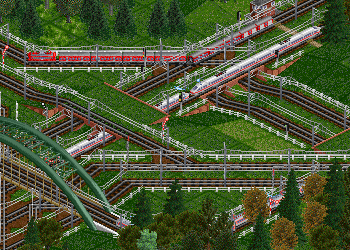 Around the year 2000, all trains have been modernized once again. For long
distance services, ICE3 units and ICs hauled by the new class 101 are used,
replacing the old standard electric engines of the 1950ies as well as the class
103. Regional connections are serviced by classes 111 and 420, but only because
the DBSet does not (yet) contain newer replacement types. Here we can see a ICE
and a regional train at the crossing near Hannover, hidden behind the trees is a
class 420 EMU.
Around the year 2000, all trains have been modernized once again. For long
distance services, ICE3 units and ICs hauled by the new class 101 are used,
replacing the old standard electric engines of the 1950ies as well as the class
103. Regional connections are serviced by classes 111 and 420, but only because
the DBSet does not (yet) contain newer replacement types. Here we can see a ICE
and a regional train at the crossing near Hannover, hidden behind the trees is a
class 420 EMU.
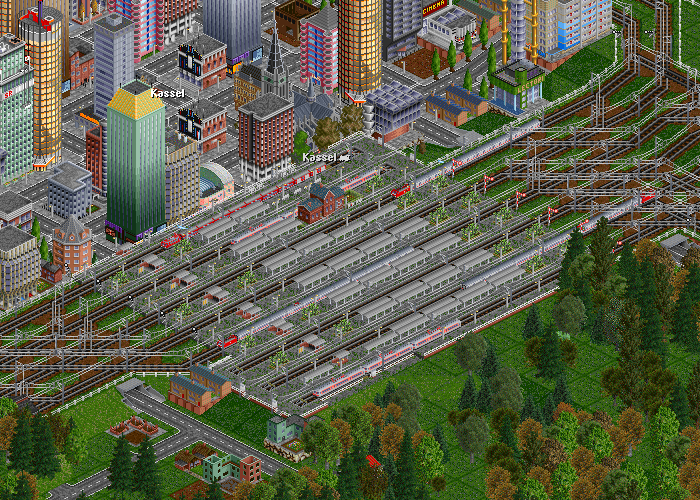 The tutorial ends with a picture of the oldest station of the network: At Kassel
we started building our network 80 years ago. By now the station has eight
platforms, regional and long-distance trains are running to all corners of the
map. The city itself has also grown considerably, one can compare it with the
first screenshots, with the church forming a reference point.
The tutorial ends with a picture of the oldest station of the network: At Kassel
we started building our network 80 years ago. By now the station has eight
platforms, regional and long-distance trains are running to all corners of the
map. The city itself has also grown considerably, one can compare it with the
first screenshots, with the church forming a reference point.
